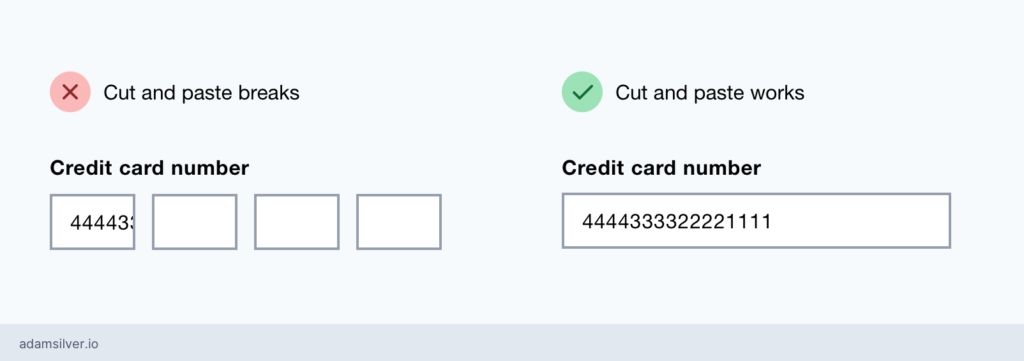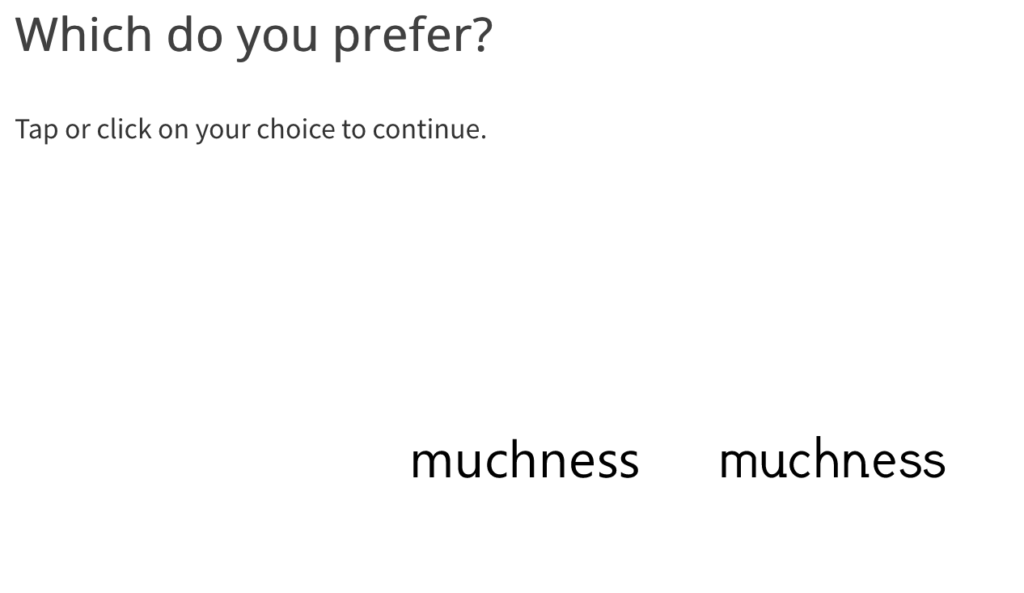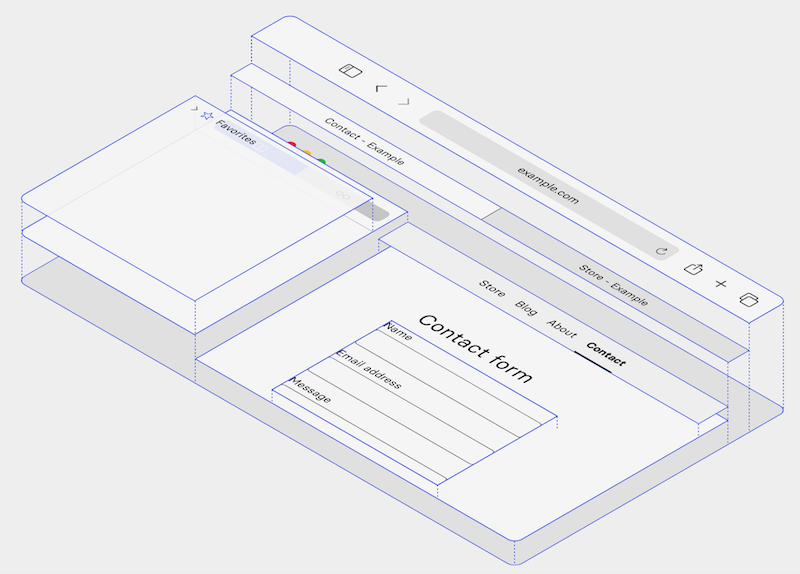Your fortnightly frequent11y newsletter, brought to you by @ChrisBAshton:

Form design: multiple inputs versus one input
- Blog post by Adam Silver, explaining why splitting inputs can be problematic. A technique often used for credit card numbers and bank sort-codes, I’ve often found such forms quite slick, but hadn’t considered some of their accessibility downsides:
- Multiple inputs mean users can’t easily paste information in, unless JavaScript has been written to allow it (which may not be obvious to the user).
- It can be difficult to correct mistakes if the form auto-focuses the next input in the sequence.
- Each input is difficult to label meaningfully. The label is often hidden from sighted users, if provided at all, and makes for a noisy screen reader experience.
- Instead, Adam encourages us to allow free-form text and to be forgiving of extra spaces and dashes in inputs. The exception is dates, where multiple inputs should be used, to clarify which portion of the date is the month and which is the day (as this varies around the world).
Glove translates sign language in real-time – ’99 percent recognition rate’
- A Daily Express article from last summer. Bioengineers at the University of California have developed a glove that can translate sign language into speech in real-time, using an accompanying smartphone app.
- The glove has thin sensors running to the fingertips, which can detect motions. The smartphone app uses a custom machine learning algorithm to convert the gestures into letters, numbers and words, and can recognise 660 signs. It translates at a speed of one word per second, with an accuracy rate of 98.63%.
- The glove has its critics. Gabrielle Hodge, a deaf researcher at University College London, says: “there is nothing wrong with [sign language as a] form of communication” and that the technology is “redundant”, due to deaf signers already making extensive use of text-to-speech software.

The Readability Group – Survey
- The Readability Group is a collection of experts in design and accessibility. Their mission is to “optimise typographic accessibility by providing expert advice based on data, not anecdote”. Essentially, they want to gather real user feedback on the readability of typography.
- Please take around twenty minutes of time to contribute to the “Readability survey”, which has been nearly 2 years in development!
Infinite Scroll: What Is It Good For?
- Article exploring the pros and cons of infinite scroll. The pros were simply “seamless mobile scrolling” and “serendipitous browsing”. The cons were numerous:
- Could contribute to social media addiction.
- Might make sidebars and other content inaccessible to assistive technology users.
- Makes footers impossible to reach.
- Causes users to lose their place (especially when hitting the ‘Back’ button).
- Slows down users who have specific goals (e.g. wanting to jump to a letter midway through the alphabet).
- Tips to improve infinite scroll implementations:
- Don’t place content below the infinite scroll.
- Code in some logic to allow ‘Back’ interactions to keep their place.
- Let user skip to particular numbers/letters.
- Ensure it works for keyboard users.
Accessibility auditing and ego
- A very popular article among a11y newsletters at the moment. Eric Bailey reminds us that WCAG is a standard, that sets “objective criteria for what is and is not accessible”. In other words, you might hate the design of a website, but it might conform to all WCAG criteria. Don’t creatively reinterpret what a Service Criterion says to fit your agenda.
- As a designer, you can appeal to a product’s usability, giving subjective feedback grounded in objective origins. But in an auditing context, you have to kill your ego and only point out failures that map to WCAG rules.
- Eric says you should think like a lawyer: every call you make might have to be defended in a court of law [it’s worth noting that this article is written from an American point of view]. That is to say, “stay in your lane”, by sticking to established, legally accepted parameters, i.e. WCAG.
- News organisation ProPublica ‘translated’ one of their articles into plain language, in an effort to be more accessible to people with intellectual/developmental disabilities.
- Here’s the original article: People with Developmental Disabilities Were Promised Help. Instead, They Face Delays and Denials.
- And here’s the plain text version: Arizona Promised to Help People With Developmental Disabilities. But Some Had to Wait a Long Time. Some Did Not Get Help at All.
- It’s fascinating to read the articles side by side and see how they compare. The plain language version simplifies sentences, writes in active voice, and uses bullet points for lists.
12 Common Words and Phrases You May Not Realise Are Ableist
- Some of these seem fairly obvious, but others less so. With respect to autism, “high or low functioning” is an ableist term I hadn’t considered. ‘Differently abled’ and ‘special needs’ are also poor euphemisms for the term ‘disabled’. ‘Tone deaf’ and ‘blind spot’ are also terms in common usage, but which harmfully link deafness/blindness with ignorance.
- The other phrases this article considers ableist are ‘imbecile’, ‘crippled’, ‘spastic’, ‘lame’, ‘suffering’ (as in “suffering from [disability]”), ‘wheelchair bound’ (in reality, many wheelchair users find their wheelchairs liberating) and finally, a saying I hadn’t heard before: “See the Able, Not the Label”.

How to start testing screen reader support using VoiceOver
- Article by Yakim van Zuijlen, describing how to use VoiceOver on a Mac to test your website. It’s aimed at beginners, but goes into quite a lot of detail, including how to find items by type (e.g. blockquote). There are some beautiful, clear illustrations throughout the article, showing which keys to press to trigger shortcuts, or how elements in the browser are grouped together by VoiceOver.
5 Ways You’re Not Making Your Website Accessible
- A listicle by Twan Mulder, which I wasn’t expecting to learn anything from – but then I learned something from the very first point! It was this:
- You often need to denote the ‘current’ page in navigation, and you see this in the wild with
class="active"or similar in the markup. Instead, it should usearia-current="page", to tell screen readers this is a link to the same page they’re already on. - The other tips are to use
aria-hiddento hide decorative separators between links; add visually hidden text to your icon links; apply ARIA markup to your<div>if you insist on not using a<button>; and, somewhat obviously, providealttext for your images.
Empathy and innovation: How Microsoft’s cultural shift is leading to new product development
- Microsoft software engineer Swetha Machanavajhala is deaf and relies on lip-reading. Whenever she Skyped her parents, she had to ask them to turn the lights off behind them so that she could more easily focus on their faces.
- She wondered if technology could solve this problem for her, so worked with Microsoft to build a background-blurring feature for Microsoft Teams and Skype (it’s not clear in the article exactly how Swetha achieved this). This feature has a useful side-effect as being a privacy tool to help users hide their backgrounds during calls.
- Thanks to Lee Goudie for pointing me towards this excellent example of Universal Design!
Did you know that you can subscribe to dai11y, week11y, fortnight11y or month11y updates! Every newsletter gets the same content; it is your choice to have short, regular emails or longer, less frequent ones. Curated with ♥ by developer @ChrisBAshton.